Article from Arno Werkzeuge
To put it bluntly, everyone is much happier when they do not need products from Eberle Medizintechnik. Well, not as such. On the other hand, they are extremely welcome when it comes to minimal invasive surgery and operations. However, then they must meet the highest standards with regards to functionality, quality and sterilisation. For many years, Arno Werkzeuge has been a reliable partner servicing the requirements of Eberle with high-quality tools and a tool management system. This ensures that precision remains second nature when it is a matter of flesh and blood.
“We need the highest precision and best surface qualities for our surgical instruments,” emphasises Bernd Amann, technical director at Eberle GmbH & Co. KG, “and Arno Werkzeuge is an excellent partner who backs us up with consultation and products.”
The sheer amount of quality know-how incorporated at Eberle only comes to light after a brief look at its production depth. The Swabian "hidden champion" even makes its own cables and connectors. So, it is no wonder that experts also call on professionals for cuttings tools to manufacture medical instruments of the highest quality and functionality, as well as their consulting services.
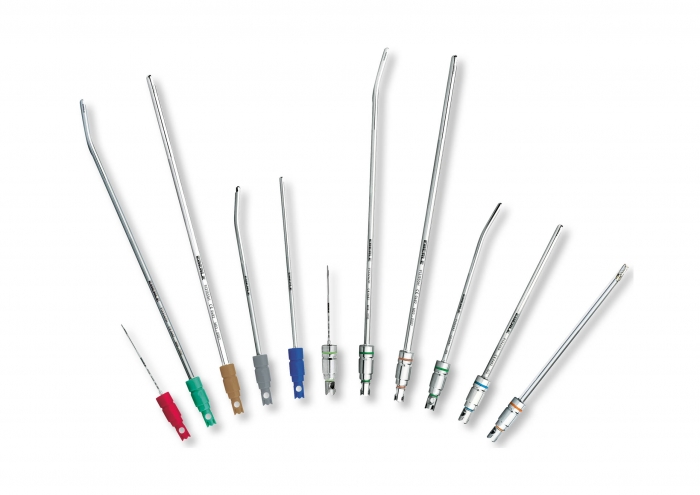
Eberle Medizintechnik is well known for its high quality and a wide range of shaver blades.
Nothing is left to chance – almost everything is produced in-house
The Eberle product portfolio comprises about 1,000 products manufactured to a production depth of almost 100%. This mainly includes shaver blades for arthroscopies, surgical and urological operations or ENT operations and drills, sawing blades and wires including the associated drive systems and hand instruments. High quality is most apparent in the shaver blades. Guide tubes and internal tools are produced in a number of turning, grinding, laser welding and sometimes hardening operations.
For example, tool tips are 8 mm long with diameters of 4.5 mm or 3.5 mm. Together with the openings for cutting tools, they are welded to the tubes in a laser welding process. The drilling and cutting tools rotate inside the guide tubes. As expected, Eberle also produces the gear wheels on the cutting heads. The superior machine pool includes lathes for Swiss and fixed headstock machining from Star, Boley and Index and a 5-axis milling center from Chiron, vertical eroding and wire EDMs, grinding machines and laser welding machines.
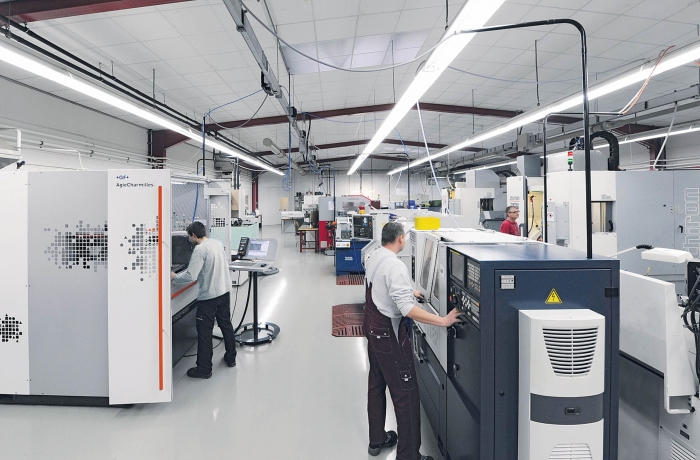
Bursting at the seams and soon to relocate to a new building: production at Eberle in Wurmberg.
Since Eberle was founded in 1999, the company has used turning, grooving, drilling and milling tools from Arno Werkzeuge. The experts from Wurmberg are looking forward to relocating their production to a new building in the foreseeable future as the present facilities are bursting at the seams. The company uses nine different VHM milling cutters, eight different SA grooving tools, the AKB drilling system and eleven types of ground high-positive indexable inserts from Arno Werkzeuge.
“In particular, the high-positive indexable inserts impress us time and again since they produce extremely good surface finishes and have long tool lives,” Amann says.
Arno Sales Engineer Alexander Rentschler explains why: “These specially developed high-positive chip geometries achieve optimum machining results by using high-performance cutting materials – also because they produce less vibration during the turning process. Not only that, the polished surface optimizes chip evacuation and the ground circumference ensures very high accuracy.” Amann confirms this with his own observations that “the finish quality is so high that some downstream process steps are no longer necessary.” This is also a key factor in minimizing the adhesion of germs to products which are later cleaned and sterilized.
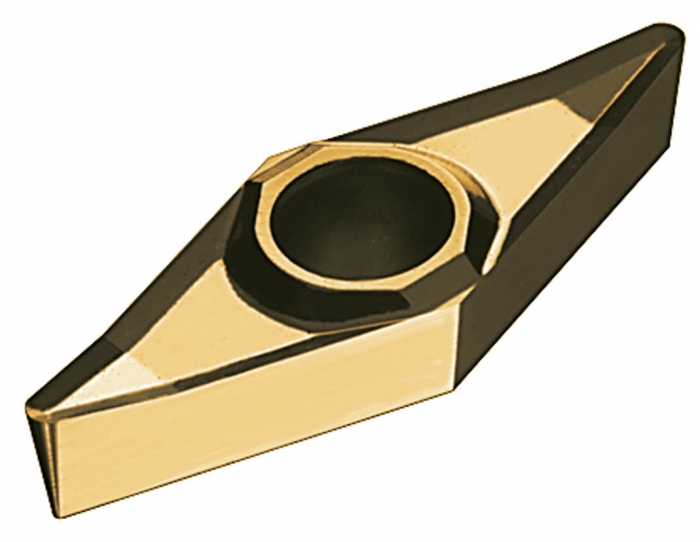
High-positive indexable inserts from Arno Werkzeuge impart a fine finish by optimizing chip evacuation due to their ground circumference and polished surfaces.
World-wide special feature for ENT instruments
Amman relies on SA modules from Arno Werkzeuge for grooving work. Among them are modules with inserts chamfered at 15° for grooving thin-walled tubes. “The tubes are mainly used for our shaver blades for ETN operations,” Amann reports. The sturdy, narrow grooving blades that Arno offers for cutting depths of 10 to 70 mm and grooving widths of 1.5 to 8 mm are the optimal solution for him “since they ensure high process reliability. And that’s important for us since our series are not very large.” A series may range from five to 5,000 units and batches are manufactured in volumes of maximum 500 units. “This means we cannot afford to have any rejects.”
ETN instruments are special products. After the guide tubes are manufactured, they are bent at radii of 50° to 65°. Of course, the drive inside the tubes must play along. In this case, Eberle uses small drive elements that transfer rotational movement via spur gears. Up to nine bevel gears of this type are mounted in an instrument. The instrument must also accommodate a flushing duct.
“Here, we are talking about internal diameters of only a few millimeters,” says Amann. It is only by applying this unique world-wide technical solution that allows bent Eberle ETN instruments to rotate at 12,000 rpm for maximum half an hour before the single-use instruments are disposed of.
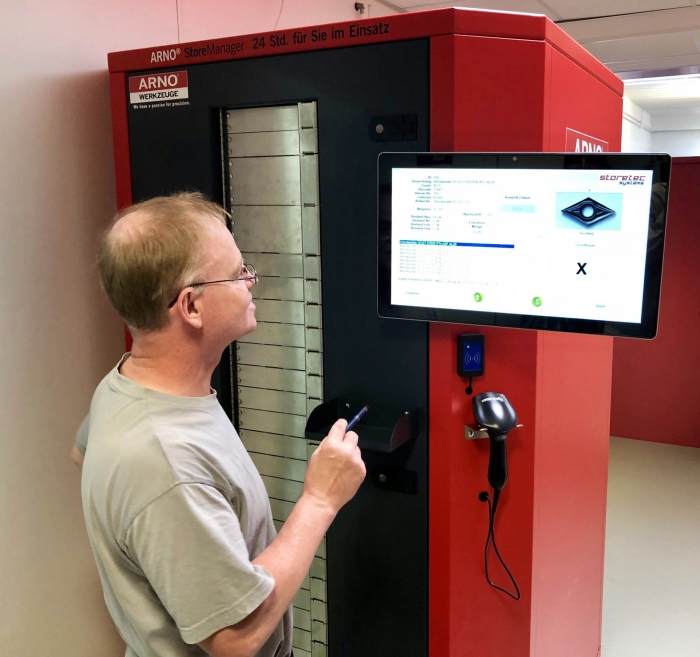
With the Arno StoreManagerPRO, Eberle benefits from smooth functioning tool management, tool tracing and tool restocking, which results in more efficient internal production processes.
Openness in tool management is well received
Eberle has opted for the StoreManagerPRO from ARNO Werkzeuge for its tool management system. A footprint of only 1.5 square meters is all it takes to store and manage tools in up to 2,160 compartments. At present, Eberle still uses it for approximately 600 to 700 tools including gauges, as well as keys for the vehicle fleet, as an employee says with a grin.
“That’s not so unusual,” says Simon Lang, product manager of tool management ystems at Arno Werkzeuge. “In fact, it’s an excellent way to track who is currently driving which vehicle for what purpose.”
Amann intends to expand the options since he is convinced by the modular system that allows controlled single withdrawal and restorage. “With the ARNO StoreManagerPRO we benefit from smooth functioning tool management, tracing and restocking – and this raises the efficiency of our internal production processes.”
He also appreciates that the tool management system can be flexibly configured; it is extremely robust, easy to operate and operational round the clock. The system offers many options for customising the software and configuring the maximum 2,160 compartments. It makes tool management and repurchasing simpler and more efficient.
Order proposals can be produced easily and straightforwardly for the purchasing department at any time, or order procedures can be initiated to any number of suppliers. The practical orientation of the software design permits users to conveniently edit data from a workplace PC. One feature that is particularly well received is that the StoreManagerPRO can also manage third-party tools “since of course, we also use products from other manufacturers,” says Amann, explaining standard practice at the company.
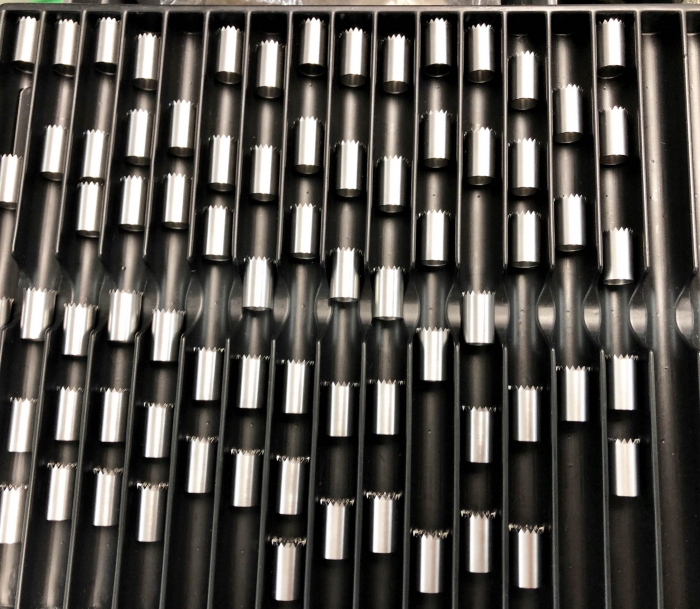
Eberle succeeds in achieving repeatable precision and process reliability with tools from Arno.
White label and private labels for the well-known companies
Eberle not only manufactures endoscopic and surgical instruments, it also supplies the associated control units together with the software and housings, as well as the cables and connectors. So, Eberle is not only inside the products on which the name of Eberle appears, Eberle is also integrated in many products made by renowned German manufacturers and market leaders in their segments.
“We have been making private label products for them for years,” explains Managing Director Frank Eberle.
Together with Arno Werkzeuge, this has worked out well for many years “because quality and consulting also come as second nature to us,” concludes Rentschler.
Related Glossary Terms
- gang cutting ( milling)
gang cutting ( milling)
Machining with several cutters mounted on a single arbor, generally for simultaneous cutting.
- grinding
grinding
Machining operation in which material is removed from the workpiece by a powered abrasive wheel, stone, belt, paste, sheet, compound, slurry, etc. Takes various forms: surface grinding (creates flat and/or squared surfaces); cylindrical grinding (for external cylindrical and tapered shapes, fillets, undercuts, etc.); centerless grinding; chamfering; thread and form grinding; tool and cutter grinding; offhand grinding; lapping and polishing (grinding with extremely fine grits to create ultrasmooth surfaces); honing; and disc grinding.
- grooving
grooving
Machining grooves and shallow channels. Example: grooving ball-bearing raceways. Typically performed by tools that are capable of light cuts at high feed rates. Imparts high-quality finish.
- hardening
hardening
Process of increasing the surface hardness of a part. It is accomplished by heating a piece of steel to a temperature within or above its critical range and then cooling (or quenching) it rapidly. In any heat-treatment operation, the rate of heating is important. Heat flows from the exterior to the interior of steel at a definite rate. If the steel is heated too quickly, the outside becomes hotter than the inside and the desired uniform structure cannot be obtained. If a piece is irregular in shape, a slow heating rate is essential to prevent warping and cracking. The heavier the section, the longer the heating time must be to achieve uniform results. Even after the correct temperature has been reached, the piece should be held at the temperature for a sufficient period of time to permit its thickest section to attain a uniform temperature. See workhardening.
- milling
milling
Machining operation in which metal or other material is removed by applying power to a rotating cutter. In vertical milling, the cutting tool is mounted vertically on the spindle. In horizontal milling, the cutting tool is mounted horizontally, either directly on the spindle or on an arbor. Horizontal milling is further broken down into conventional milling, where the cutter rotates opposite the direction of feed, or “up” into the workpiece; and climb milling, where the cutter rotates in the direction of feed, or “down” into the workpiece. Milling operations include plane or surface milling, endmilling, facemilling, angle milling, form milling and profiling.
- sawing
sawing
Machining operation in which a powered machine, usually equipped with a blade having milled or ground teeth, is used to part material (cutoff) or give it a new shape (contour bandsawing, band machining). Four basic types of sawing operations are: hacksawing (power or manual operation in which the blade moves back and forth through the work, cutting on one of the strokes); cold or circular sawing (a rotating, circular, toothed blade parts the material much as a workshop table saw or radial-arm saw cuts wood); bandsawing (a flexible, toothed blade rides on wheels under tension and is guided through the work); and abrasive sawing (abrasive points attached to a fiber or metal backing part stock, could be considered a grinding operation).
- turning
turning
Workpiece is held in a chuck, mounted on a face plate or secured between centers and rotated while a cutting tool, normally a single-point tool, is fed into it along its periphery or across its end or face. Takes the form of straight turning (cutting along the periphery of the workpiece); taper turning (creating a taper); step turning (turning different-size diameters on the same work); chamfering (beveling an edge or shoulder); facing (cutting on an end); turning threads (usually external but can be internal); roughing (high-volume metal removal); and finishing (final light cuts). Performed on lathes, turning centers, chucking machines, automatic screw machines and similar machines.
